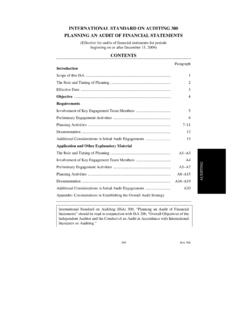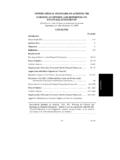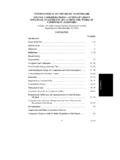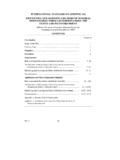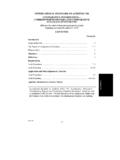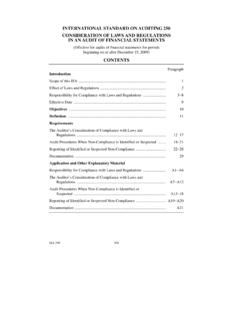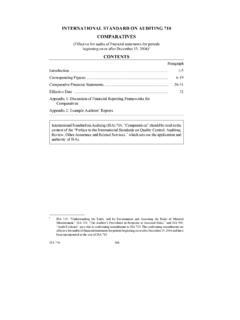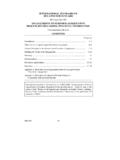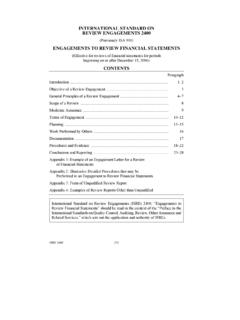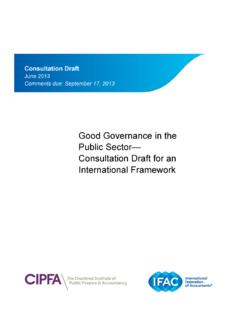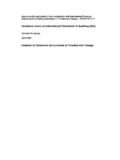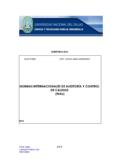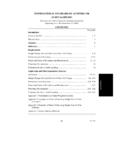Transcription of INTERNATIONAL STANDARD ON AUDITING 320 …
1 ISA 320 313 AUDITING INTERNATIONAL STANDARD ON AUDITING 320 materiality IN PLANNING AND PERFORMINGAN AUDIT (Effective for audits of financial statements for periods beginning on or after December 15, 2009) CONTENTS Paragraph Introduction Scope of this ISA .. 1 materiality in the Context of an Audit .. 2 6 Effective Date .. 7 Objective .. 8 Definition .. 9 Requirements Determining materiality and Performance materiality When Planning the Audit .. 10 11 Revision as the Audit Progresses .. 12 13 Documentation .. 14 Application and Other Explanatory Material materiality and Audit Risk .. A1 Determining materiality and Performance materiality When Planning the Audit.
2 A2 A12 Revision as the Audit Progresses .. A13 INTERNATIONAL STANDARD on AUDITING (ISA) 320, materiality in Planning and Performing an Audit should be read in the context of ISA 200, Overall Objectives of the Independent Auditor and the Conduct of an Audit in Accordance with INTERNATIONAL standards on AUDITING . materiality IN PLANNING AND PERFORMING AN AUDIT ISA 320 314 Introduction Scope of this ISA 1. This INTERNATIONAL STANDARD on AUDITING (ISA) deals with the auditor s responsibility to apply the concept of materiality in planning and performing an audit of financial statements. ISA 4501 explains how materiality is applied in evaluating the effect of identified misstatements on the audit and of uncorrected misstatements, if any, on the financial statements.
3 materiality in the Context of an Audit 2. Financial reporting frameworks often discuss the concept of materiality in the context of the preparation and presentation of financial statements. Although financial reporting frameworks may discuss materiality in different terms, they generally explain that: Misstatements, including omissions, are considered to be material if they, individually or in the aggregate, could reasonably be expected to influence the economic decisions of users taken on the basis of the financial statements; Judgments about materiality are made in light of surrounding circumstances, and are affected by the size or nature of a misstatement, or a combination of both.
4 And Judgments about matters that are material to users of the financial statements are based on a consideration of the common financial information needs of users as a The possible effect of misstatements on specific individual users, whose needs may vary widely, is not considered. 3. Such a discussion, if present in the applicable financial reporting framework, provides a frame of reference to the auditor in determining materiality for the audit. If the applicable financial reporting framework does not include a discussion of the concept of materiality , the characteristics referred to in paragraph 2 provide the auditor with such a frame of reference.
5 4. The auditor s determination of materiality is a matter of professional judgment, and is affected by the auditor s perception of the financial information needs of 1 ISA 450, Evaluation of Misstatements Identified during the Audit. 2 For example, the Framework for the Preparation and Presentation of Financial Statements, adopted by the INTERNATIONAL Accounting standards Board in April 2001, indicates that, for a profit-oriented entity, as investors are providers of risk capital to the enterprise, the provision of financial statements that meet their needs will also meet most of the needs of other users that financial statements can satisfy.
6 materiality IN PLANNING AND PERFORMING AN AUDIT ISA 320 315 AUDITING users of the financial statements. In this context, it is reasonable for the auditor to assume that users: (a) Have a reasonable knowledge of business and economic activities and accounting and a willingness to study the information in the financial statements with reasonable diligence; (b) Understand that financial statements are prepared, presented and audited to levels of materiality ; (c) Recognize the uncertainties inherent in the measurement of amounts based on the use of estimates, judgment and the consideration of future events; and (d) Make reasonable economic decisions on the basis of the information in the financial statements.
7 5. The concept of materiality is applied by the auditor both in planning and performing the audit, and in evaluating the effect of identified misstatements on the audit and of uncorrected misstatements, if any, on the financial statements and in forming the opinion in the auditor s report. (Ref: Para. A1) 6. In planning the audit, the auditor makes judgments about the size of misstatements that will be considered material. These judgments provide a basis for: (a) Determining the nature, timing and extent of risk assessment procedures; (b) Identifying and assessing the risks of material misstatement; and (c) Determining the nature, timing and extent of further audit procedures.
8 The materiality determined when planning the audit does not necessarily establish an amount below which uncorrected misstatements, individually or in the aggregate, will always be evaluated as immaterial. The circumstances related to some misstatements may cause the auditor to evaluate them as material even if they are below materiality . Although it is not practicable to design audit procedures to detect misstatements that could be material solely because of their nature, the auditor considers not only the size but also the nature of uncorrected misstatements, and the particular circumstances of their occurrence, when evaluating their effect on the financial Effective Date 7.
9 This ISA is effective for audits of financial statements for periods beginning on or after December 15, 2009. 3 ISA 450, paragraph A16. materiality IN PLANNING AND PERFORMING AN AUDIT ISA 320 316 Objective 8. The objective of the auditor is to apply the concept of materiality appropriately in planning and performing the audit. Definition 9. For purposes of the ISAs, performance materiality means the amount or amounts set by the auditor at less than materiality for the financial statements as a whole to reduce to an appropriately low level the probability that the aggregate of uncorrected and undetected misstatements exceeds materiality for the financial statements as a whole.
10 If applicable, performance materiality also refers to the amount or amounts set by the auditor at less than the materiality level or levels for particular classes of transactions, account balances or disclosures. Requirements Determining materiality and Performance materiality When Planning the Audit 10. When establishing the overall audit strategy, the auditor shall determine materiality for the financial statements as a whole. If, in the specific circumstances of the entity, there is one or more particular classes of transactions, account balances or disclosures for which misstatements of lesser amounts than materiality for the financial statements as a whole could reasonably be expected to influence the economic decisions of users taken on the basis of the financial statements, the auditor shall also determine the materiality level or levels to be applied to those particular classes of transactions, account balances or disclosures.
